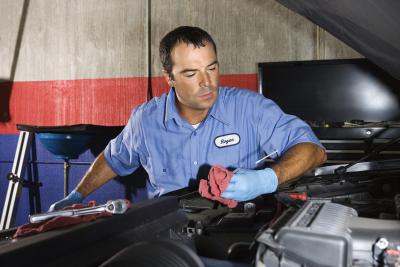
The alternator replacement process on the 1994 Nissan Sentra requires a bit more work than a basic alternator replacement job. The alternator controls the vehicle's charging system--it keeps the battery charged and all of the electrical components working. Without the alternator, the Sentra's engine would not crank and the lights would not function.
Park the 1994 Nissan Sentra on a even surface and open the hood.
Remove the negative battery cable from the negative battery post with an adjustable wrench. The negative battery post will have a (-) symbol stamped on the battery above the negative battery post.
Locate the serpentine belt tensioner on the front of the engine. (The belt will have to be removed from the alternator pulley before the alternator can be pulled out of the engine compartment. The tensioner has a spring loaded arm and a pulley.)
Turn the tensioner counterclockwise with the 1/2-inch drive ratchet and a socket. Slide the belt off of the alternator pulley. Let the belt hang down but do not let the belt come off the other pulleys.
Locate the three wire connectors on the rear of the alternator. Two of the wire connectors are plugged in to the rear of the alternator, and the other wire connector is held on by a nut. Unplug the two wire connectors and unscrew the other wire connector with the 1/2-inch drive ratchet and a socket. Place any nuts and bolts in a small container for safekeeping.
Remove the two bolts from the front of the alternator bracket with the 1/2-inch drive ratchet and a socket. Put the two front bracket bolts into the small container.
Jack up the front of the 1994 Nissan Sentra and slide the jack stands under the frame of the car behind each front tire. Slowly lower the car onto the stands. Examine the jack stands to ensure that the Sentra is sitting securely on top of the stands.
Locate the two splash shields below the engine, behind the rear of the front driver side tire. One of the splash shields is attached to the metal cross brace under the driver side of the engine; the other is connected to the driver side wheel well. Remove the bolts from the splash shields with the ratchet and a socket. Pull the splash shields out of the way and set them to the side.
Look up through the splash shield hole and locate the two lower alternator mounting bracket bolts. Remove these two bolts with the 1/2-inch drive ratchet and socket.
Go back to the top of the engine and pry back and forth on the alternator with the pry bar to loosen the alternator from the alternator bracket. Pull the alternator out of the alternator bracket with your hands and set the old alternator to the side.
Slide the new alternator into the alternator bracket. Crawl back under the Sentra and line the two lower alternator holes up with the two lower bracket holes. Screw the two lower bolts into the alternator and tighten them down with the 1/2-inch drive ratchet and socket.
Install one of the splash shields back to the metal cross brace under the driver side of the engine. Install the other splash shield to the driver side wheel well. Tighten down the splash shield bolts with the 1/2-inch drive ratchet and socket. Jack the Sentra back up and remove the jack stands. Lower the Sentra to the ground.
Go back to the top of the engine and plug the two rear wire connectors back into the rear of the alternator. (The plugs are different sizes so that each connector will only fit the plug that it was designed for.) Put the other wire back onto the stud and screw the nut back on. Tighten the nut down with the ratchet and socket.
Turn the serpentine belt tensioner counter clockwise again and slide the belt back onto the alternator pulley with the 1/2-inch drive ratchet and socket.
Put the negative battery cable back onto the negative battery post and tighten down with the ratchet and socket. Crank the engine to make sure that the alternator is working properly.